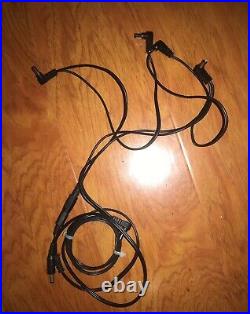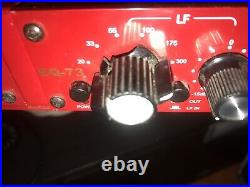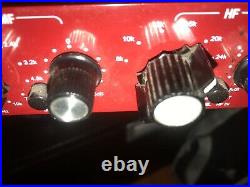Golden Age Project Pre 73 DLX, EQ 73 And PS-AC4 Power Supply Distributor







Golden Age Project Pre 73 DLX, EQ 73 And PS-AC4 Power Supply Distributor. The DLX variant includes some bonus features and higher-grade components. There's a switchable, inductor-based, high-pass filter at the input, which can be set to 50, 80, 160 or 300 Hz (and can, of course, be switched off).
There's also a post-transformer output pad, offering 0, -7, -14, -21 and -28dB options. The former allows you to get rid of unwanted rumbles and thumps, or to take the bottom end out of cymbal mics, for example, whereas the latter enables you to drive the preamp much harder, to coax distortion and saturation effects not only from the mic and line input transformers but also the output transformer. A nice touch, I think you'll agree!
There's also a selectable active/passive DI input, the active signal being selectable pre or post the mic-input transformer, and a redesigned power supply, with separate regulators for the audio, LED and relay circuits. Most front-panel switch functions are implemented with relays, and tantalum capacitors have been used in the signal path. The insert also has an in/out switch. As standard, the DLX preamp uses the same inductor and transformers as the Pre 73 MkII, but there's also an option to have it fitted with Carnhill models, as used on most Neve 1073 clones, and many other boutique preamps besides. The pricing differences are considerable when you replace all of the transfomers and the inductor, so I was pleased that Bo Medin the man behind GAP sent me two versions of the DLX, one with the standard options fitted, and another with all Carnhills.
That meant I could evaluate whether the upgrades are truly worthwhile. I should point out that the Carnhill models are handled in a slightly different way in the US market, via separate distributors who offer their own standard'mod'. The EQ73 is based on the EQ section of Neve's revered 1073 channel strip, and is pretty faithful to the Neve design. The only real departure is the use of a second inductor for the mid-range band, the idea being to achieve a more suitable response for the two lowest frequencies. There's no need for transformers here, as the EQ is designed specifically to partner the Pre 73 range via the unbalanced insert point the idea being that you already have the balancing transformers in the preamp, so don't need them here. The two devices are linked by a single stereo cable that carries both the send and return from each unit.Other than the power inlet and a ground lift-switch, that's all there is on the rear panel. On the front, of course, you'll find all the controls, which comprise a frequency knob, a gain/attenuation knob, and an EQ in/out switch for each of three bands, LF, MF and HF.
There's also a global on/off button, but there's no global EQ bypass: that function is taken care of by an insert on/off button on the preamp. The frequency selectors are stepped switches, whereas gain/attenuation is governed by variable pots, although, usefully, these do have a centre detent at 0dB gain.
The mid-range EQ band is a bell type and the other two are shelves, so if you want a high-pass filter you'll need to look to the DLX preamp (or use a mic with a filter built in). The Q is fixed, as in the original Neve circuit, but that's fine, as this is clearly intended as a tone-shaping tool rather than a surgical instrument.
The low band (LF) offers up to ±15dB gain at 20, 33, 55, 100, 175 or 300 Hz; the mid-range (MF) again provides ±15dB, this time at 160, 240, 350, 500 and 700 Hz, and 1, 1.6, 2.4, 3.2, 4.8, 7 and 10 kHz; and the high band (HF) offers up to ±18dB at 8, 10, 12, 16, 20 and 24 kHz. The bands therefore just overlap in a useful way, and extend from 20Hz to 24kHz, making this a very versatile processor.
The power supply distributor has a main D plug that plugs in from the wall (115VAC or 230VAC switch) and distributed out to four 24VAC outputs that provide the proper power to the proprietary audio units. THE CHAINED POWER CABLE WITH THEIR SOCKETS THAT CONNECT MULTIPLE UNITS TOGETHER ELIMINATING THE NEED FOR INDIVIDUAL POWER ADAPTOR THUS CONSERVING SPACE.
Very Good describes items with more cosmetic imperfections than Excellent but is still in great condition overall. With a Very Good guitar, for example, you might find some scratches, buckle rash, or other minor blemishes but nothing that affects the playability or function of the instrument. The item "Golden Age Project Pre 73 DLX, EQ 73 And PS-AC4 Power Supply Distributor" is in sale since Saturday, March 28, 2020. This item is in the category "Musical Instruments & Gear\Pro Audio Equipment\Preamps & Channel Strips".
The seller is "vandenplasxjs" and is located in Los Angeles, California. This item can be shipped to United States.- Brand: Golden Age Project
